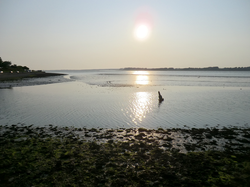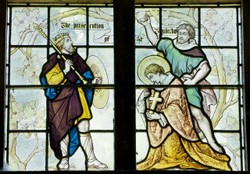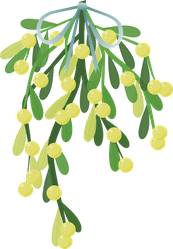In one version, the soldiers had found the one place where the waters could be forded (thus showing how much the Irish Sea has risen over the past two thousand years); or else they created a pontoon of boats to act as a bridge, as told in version two. Then they hesitated in pure intimidation.
Tacitus's Annals describes why:
On the shore stood the opposing army with its dense array of armed warriors, while between the ranks dashed women, in black attire like the Furies, with hair disheveled, waving brands.
All around, the Druids, lifting up their hands to heaven, and pouring forth dreadful imprecations, scared our soldiers by the unfamiliar sight, so that, as if their limbs were paralyzed, they stood motionless, and exposed to wounds.
Paulinus basically appealed to the male pride of his soldiers, scorning them in fearing a bunch of women. Testosterone raised along with their standard, the Romans rushed onto the island. They wrestled the brands from the hands of Druidesses, then used them to set fire to the ladies and their groves alike. Elsewhere other Druids were killed with swords over their own altars.
By the time the Menai Massacre was over, everything that represented Druidism - human, site and artifact alike - was destroyed. The old Celtic faith had lost its center of operations, but the conquest couldn't be made certain immediately. Paulinus had to quickly withdraw from the slaughter, as news reached him that Boudicca begun her uprising in the south.
But it was too important to simply tear down and walk away. Places like that could be rebuilt.
Eighteen years later, Gnaeus Julius Agricola made it a priority to secure Ynys Môn, even while much of the rest of Britain was outside the Empire's control. In 78 CE, the Roman Governor of Britain completed the conquest of Anglesey and built a fortress straddling both sides of the Menai Straits.
Segontium was one of the first Roman sites to be populated with a permanent cohort of legionnaires. It was also one of the last to be abandoned, after 410 CE, trailing after the general Roman withdrawal from Britain.
Christianity had long since flooded into the area by then, brought by missionaries traveling throughout the Roman Empire. So what happened to the Druid faith then?

















 St Tydecho's Churches in West Waleson 09/03/2014
St Tydecho's Churches in West Waleson 09/03/2014
 Goodies for an Outlander Premiere Partyon 03/06/2015
Goodies for an Outlander Premiere Partyon 03/06/2015
 Holocaust Memorial Day Interview with Rainer Höss, Grandson of Rudolf Architect of Auschwitzon 01/24/2015
Holocaust Memorial Day Interview with Rainer Höss, Grandson of Rudolf Architect of Auschwitzon 01/24/2015
 Romantic Valentine Gifts for an Outlander Fanon 01/16/2015
Romantic Valentine Gifts for an Outlander Fanon 01/16/2015



Comments
Link suggesting that Môn before the Romans was Menapii.
It's also the theory of Norman Mongan in "Menapia Quest".
The influent druids were very probably Menapians druids.
https://translate.google.com/translat...
Ah! Yes, true story. It's been a while since I read it. Perhaps I'll join you with a re-read.
If there was a conversion on any significant scale we must recall that Ireland was several kingdoms and the poltics of one would differ from the poltics of others, and poltics were very fluid, so purely poltical conversions would not last.
I'd heard, but forgotten that, many years ago. Thank you for the reminder. It does seem that the early Christian Church, at least in Eire, was Druidic. I wonder if it was a political or spiritual conversion.
Thanks, Jo. That's next book on the reading list after I finish my present one. What is worth noting in connection with what you say is that the Irish church used the druidic tonsure,in which the hair was shaven at the front. This does indicate that the Christians did not see the druidic tradition as totally inimical to what they stood for.
You REALLY should read Thomas Cahill's 'How the Irish Saved Civilisation'. He basically argues that the Druids in Ireland converted en masse to Christianity, and that the Church there was basically the Druidic network - and admin etc - under another name. When the Vandals sacked Rome, followed by the Huns et al, then it was the Irish Church which effectively became the temporary centre of Christianity around the world. They were able to provide all of the documentation later, when the Roman Church was ready to rebuild.
I'm no expert here, so I can't judge how credible Cahill's evidence and arguments are, but it sounds like something you could really get your teeth into.
That's interesting stuff.
But today when reflecting on Ynys Mon and the fate of the Druids I realized how the Romans shot themselves in the foot with the massacre. In slaughtering Druids they destroyed/damaged the most intellectually vigorous form of paganism at that time. Graeco-Roman paganism was intellectually bankrupt, but Druidism was strong and could ask questions, and it posed an alternative to the most vigorous pagan thought system at the time, Philosophy. Thus they cleared the way for the Christian faith, which they also disliked, to spread across Europe. This is not to say that I approve the massacre, as the Christian God cannot be served by murder [though the inquisition tried to do it, but they served the clerical power structure.]
Note how intellectually vigorous Irish Christianity was. Is this to do with clerics having to hone their minds in discussions with the Druids, who were strong in Erin?
At least two of my branches end up in Ireland too - though I suppose I'm looking at that like a historian, rather than a normal human being. The branches quite patently ended up here!
Yes, I frequently encounter British people wandering around Ireland (before that was a seriously bad thing). There are legends about Arthur and Merlin going. Gildas was lodged there for a while to. Lots of Welsh saints, in fact, had some time in the monasteries of Eire. Plus you get hints from the divine legends, like St Dwynwyn (not at all to be mistaken for the Welsh deity of precisely the same name and aspect and just about everything else), who was being abused by Maelgwn Gwynedd, so she walked on water across to Ireland to escape him.
I've not actually looked, but I'm certain I'm going to find British druids cropping up in the Irish Annals.
I did not know that Welsh legends chimed in with my theory about druids surviving the Roman atrocity. British pagans could cross to Ireland and seek druidic ministry/training, and some druids may have made the opposite journey as Rome's grip began to fail.
The idea of people crossing the Irish Sea appeals to me: it's how half my genes arrived here.
That would make a lot of sense. It also chimes well with the Welsh legends, both of its bards and its priests. There's a lot of them where people cross back and forth over the Irish Sea. You're probably onto something.